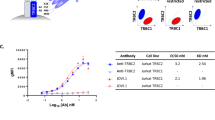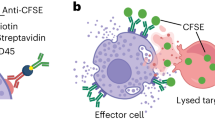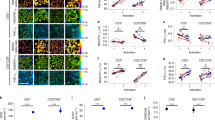Abstract
The characteristics of a single-cell immunofluorescence assay for terminal deoxynucleotidyl transferase (terminal transferase, TdT) is described. The data indicate that the single-cell immunofluorescence assay is highly efficient and specific for the detection of cells containing TdT. Using this assay, we have examined 124 marrow or peripheral-blood samples from 104 patients with or without haematological malignancies. Results indicate that TdT+ cells from 6% to 100% were found in the following patients: 34/40 samples from patients with ALL at the time of diagnosis or during relapse, 2/3 patients with acute undifferentiated leukaemia, 2/3 patients with acute myelomonocytic leukaemia, 1/24 patients with acute myeloblastic leukaemia, 1/5 patients with chronic myelocytic leukaemia (CML) in blastic crisis, and 2/2 patients with diffuse lymphoblastic lymphoma. In contrast less than 1% of TdT+ cells were found in 20 marrow or peripheral-blood samples from ALL patients in complete remission, 8 patients with CML in chronic phase, 2 patients with myeloma, 1 sample from a patient with Hodgkin's disease, peripheral-blood samples from 7 normal donors and marrow samples from 6 patients without haematological malignancies. TdT+ cells were also found in association with cells with lymphoblast morphology. The TdT+ cells in marrow were shown to be directly correlated with the percentage of morphological lymphoblasts, with a Spearman rank coefficient of 0·81, significant at a 0·001 level. In 2 longitudinal studies of 2 ALL patients with TdT+ cells at diagnosis, the percentage TdT+ cells also changed in parallel with the proportion of lymphoblasts. However, studies of 2 other patients with morphologically diagnosed ALL with < 1% TdT+ cells at diagnosis also showed < 1% TdT+ cells throughout the period studied, indicating a stable phenotype of blast cells in these patients. The single-cell immunofluorescence assay for TdT, which requires < 0·1% of the cells used in a conventional biochemical assay, is highly specific, and could provide a technically more efficient alternative for use in clinics as well as in experimental investigations of subpopulations of leukaemic and normal marrow cells.
This is a preview of subscription content, access via your institution
Access options
Subscribe to this journal
Receive 24 print issues and online access
$259.00 per year
only $10.79 per issue
Buy this article
- Purchase on Springer Link
- Instant access to full article PDF
Prices may be subject to local taxes which are calculated during checkout
Similar content being viewed by others
Rights and permissions
About this article
Cite this article
Okamura, S., Crane, F., Jamal, N. et al. Single-cell immunofluorescence assay for terminal transferase: human leukaemic and non-leukaemic cells. Br J Cancer 41, 159–167 (1980). https://doi.org/10.1038/bjc.1980.26
Issue Date:
DOI: https://doi.org/10.1038/bjc.1980.26
This article is cited by
-
Detection of the granulocyte colony-stimulating factor receptor using biotinylated granulocyte colony-stimulating factor: presence of granulocyte colony-stimulating factor receptor on CD34-positive hematopoietic progenitor cells
Research in Experimental Medicine (1992)
-
Measurement of human granulocyte-macrophage colony-stimulating factor (GM-CSF) by enzyme-linked immunosorbent assay
Biotherapy (1989)
-
Granulocyte-macrophage colony formation in vitro using human non-phagocytic bone marrow cells
Research in Experimental Medicine (1988)



